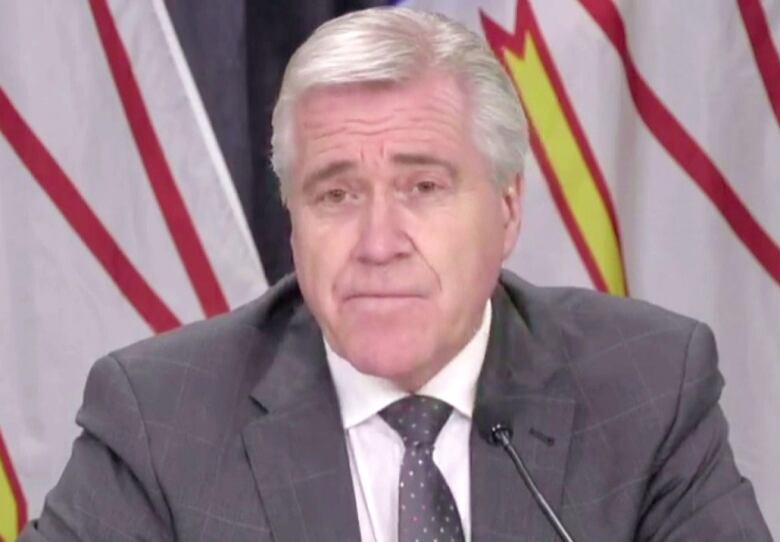First wave of COVID-19 subsiding as N.L. reports no new cases Monday
New projections are promising, but 'by no means is victory,' says Dr. Proton Rahman

With just two new cases of COVID-19 in Newfoundland and Labradorin the past 10 days,the provincial government says planning is underway to to determine when and how to relax some public health restrictions.
Dr. Proton Rahman, a professor of medicine and a clinical researcher at Memorial University's school of medicine, joined the daily briefing on Monday to discuss new COVID-19 projection models for the province.
Rahman saida team at Memorial University took two approachesto produce new projections ofCOVID-19'simpact in the province. Both models concluded the first wave is subsiding.
"You really helped crush that curve," Rahman said. "What the data shows is that the first wave the peak has actually occurred."
Watch the full April 27 update:
Rahmanpointed to several recent positive signs: zero deaths in the last two weeks, just twocases in the last 10 days and no hospital admissions in at least a week.
"This by no means is victory," said Rahman, addingthe real test comes when public health measuresbegin to be relaxed.
"It has to be slow and it has to be phased," he said. "The harder part is when you actually start to reduce the public health measures, when you start interacting, because you can lose control right away."
Premier Dwight Ball said Monday the virus will live in the provincefor many months, and residents will have to adjust accordingly.
"What is certain is that all of us are subject to the COVID-19 virus," he said."This is not something that we can wait out. We must adapt."
Rahman said businesses will have to do their own risk assessments when public health restrictions begin to lift which is still to be determined. Businesses should consider proper physical distancing and protection, as well as having enough protective equipment on hand.
Health Minister John Haggiesaid the province is currently in a "phase of embers" as the first wave of COVID-19 is getting under control but under the right conditions it wouldbe easy for the virus to begin spreading again.
"Distancing is going to bethe key to avoid fanning those embers into little local fires or clusters, and this is going to have to be a way of life," he said. "We really have to think about a 18-month to 24-month marathon, not a sprint."
"This is really a sneaky little devil and you don't know where it's going to go next."
Zero new cases on Monday
The province reported no new cases of COVID-19 on Monday, following a weekend that saw the province's total increase by a single case each day.
Newfoundland and Labrador's total number of cases is 258, with 221 people having recovered. There have been 7,622 people tested.

The weekend's two new cases ended a streak of a full week in which there had been no new cases reported.
Chief Medical Officer of Health Dr. Janice Fitzgerald said the two new cases over the weekend, following seven days with no new cases, werea reminder of the virus's unpredictability.
"As we are flattening the curve, people may think it's OK to socialize with family and friends, gather for special occasions and resume life as it was. We are not there yet," Fitzgerald said.
"Planning with public health officials is currently underway to determine how and when we may relax some of the public health measures in place."
Fitzgerald saidpublic health officials have traced more than 90 per cent of all contacts of COVID-19 patients to date.
Getting creative
Rahmanalso unveiled two different approaches to keeping the virus's spread in check. One includes voluntary digital contact tracing, the other uses artificial intelligence to guide public health measures.
Rahman said the ideas will not be ready for another month or more, but planning now will help the public begin to live with the virus.
"If the virus is going to stay, and without a vaccine, we're going to be about maybe one to two years we have to manage with this virus being here," he said.
"We need really smart solutions. You can be creative in terms of your business to come up with solutions, so you can actually start living with this virus until there is a vaccine."
Haggie said digital contact tracing would involve a cellphone application usingBluetooth technology and the user's location to notify them if they have been in proximityto someone who had been in contact with the virus.
Haggie said the tracing, which would be voluntary, would unlock thedata collected only with authorization from the user. Anyone who is notified would also have to authorize the release of their own contact list.
Haggie said jurisdictions such as South Korea and Singapore have been using a similar concept, and are touted as being excellent in managing COVID-19.
"We think we can have something up and running within a couple of weeks."
Initial models
The last models were released almost three weeks ago.
At that time, two scenarios were presented;however, unlike other provinces,potential death tolls were not included.
The first model at the time assumedcurrent restrictions would remain in place and projected32 per cent of Newfoundlanders and Labradorians infected over a two-year period.
Under that scenario, the peak of the virus would occur in early November, and the province would have enough hospital beds and ventilators to weather the pandemic.
Intensive-care units would still be overwhelmed, however, with the province projecting it would exceed capacity 57 beds when the modelling was done bylate June.
The second model projecteda scenario in which current restrictions are eased and assumes 52 per cent of people in the province infected over the same two-year period. In that scenario, the peak comes sooner mid-September and overwhelms hospital beds, intensive-care units and ventilators.












_(720p).jpg)


 OFFICIAL HD MUSIC VIDEO.jpg)
.jpg)



























































































